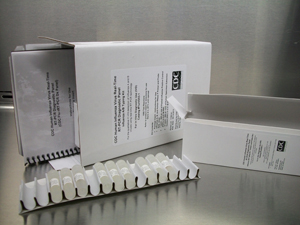This page is a historical archive and is no longer maintained.
For current information, please visit http://www.cdc.gov/media/
Press Release
For Immediate Release: September 2, 2011
Contact: CDC Online Newsroom
(404) 639-3286
New CDC-Developed Diagnostic Lab Test for Flu Approved
A laboratory diagnostic kit to diagnose human infections with seasonal influenza viruses and novel influenza A viruses with pandemic potential has been authorized for use by Food and Drug Administration. The in–vitro, or IVD, kit was developed by the Centers for Disease Control and Prevention.
“As the spread of the H1N1 pandemic slowed last year, we conducted an end–to–end review of our nation’s medical countermeasure enterprise, which showed a clear need for better diagnostic tests,” said Dr. Nicole Lurie, assistant secretary for preparedness and response in the U.S. Department of Health and Human Services. “In helping public health officials quickly identify seasonal flu as well as the flu viruses that could become pandemic, this kit can make a real difference in protecting health and saving lives in the United States and around the world.”
The CDC test kit will be given at no cost to qualified international public health laboratories to improve global laboratory capacity for detecting influenza virus infections in human respiratory tract specimens.
The CDC Human Influenza Virus Real–Time RT–PCR Diagnostic Panel utilizes a three–module design. The modules incorporate and streamline previous versions of CDC′s two separate FDA–cleared diagnostic test kits.
The first module is used to identify and distinguish between infection with influenza A and B viruses. The second module can further classify influenza A viruses by subtype, such as H1N1, H3N2 or 2009 H1N1. And the last module specifically detects highly pathogenic avian influenza A (H5N1) virus infection in human respiratory tract specimens, in support of ongoing global preparedness efforts against a possible H5N1 bird flu pandemic.
The modular design makes the kit more efficient for use by diagnostic laboratories, and eliminates waste by allowing users the flexibility to order components separately, according to the laboratory′s needs. “This will lead to more efficient testing, with cost savings for the federal government and for state and local public health agencies,” stated Nancy Cox, P.H.D., director of CDC Influenza Division and director of the World Health Organization Collaborating Center for Surveillance, Epidemiology and Control of Influenza.
The test kit is used with specimens collected from a patient’s upper or lower respiratory tract. Upper respiratory specimens are easily obtainable in an outpatient or inpatient setting, and lower respiratory specimens are typically obtained from severely ill patients with lower respiratory disease (e.g., severe pneumonia) in a hospital setting. The test kit is the only IVD for influenza that is FDA cleared for use with lower respiratory tract specimens. Several studies have shown that among hospitalized patients with severe lower respiratory disease, including critically ill patients requiring mechanical ventilation in the intensive care unit, testing lower–respiratory tract specimens can help detect influenza virus infections that can be missed by only testing upper respiratory tract samples.
###
U.S. DEPARTMENT OF HEALTH AND HUMAN SERVICES
View Press Releases in
Get email updates
To receive email updates about this page, enter your email address:
Contact Us:
- Centers for Disease Control and Prevention
1600 Clifton Rd
Atlanta, GA 30333 - 800-CDC-INFO
(800-232-4636)
TTY: (888) 232-6348 - Contact CDC–INFO
